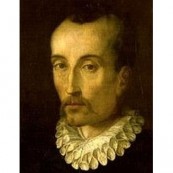Composers
Thomas Crecquillon (c. 1505 – probably early 1557) was a Franco-Flemish composer of the Renaissance. He is considered to be a member of the Netherlands school. While his place of birth is unknown, it was probably within the region loosely known at the time as the Netherlands, and he probably died at Béthune.
Very little is known about his early life. He was a member of the chapel of Emperor Charles V, but whether he was maître de chapelle or merely a singer there is still a matter of dispute; the surviving documents are contradictory. Later he seems to have held positions at Dendermonde, Béthune, Leuven, and Namur. Unlike many of the composers of the Netherlandish school he seems never to have left his home region for Italy or other parts of Europe. Most likely he died in 1557, probably a victim of the serious outbreak of plague in Béthune that year.
Crecquillon's music was highly regarded by his contemporaries, and shows a harmonic and melodic smoothness which prefigures the culminating polyphonic style of Palestrina. He wrote twelve masses, over 100 motets and almost 200 chansons. Stylistically he uses points of imitation, rather in the manner of Josquin des Prez, in almost all of his sacred works (the masses and motets), following the contemporary trend towards pervading imitation and polyphonic complexity. Unlike Josquin, however, Crecquillon rarely varies his texture for dramatic effect, preferring smoothness and consistency.
His secular chansons, unlike most of those by other composers of the same time, also use pervading imitation, although as is normal in a lighter form of music, they make considerable use of repetition (for example of the final phrase). Because they were imitative, it was Crecquillon's chansons which provided some of the best models for the later development of the instrumental canzona, the instrumental form which developed directly from the chanson. Many of his chansons were arranged for instruments, especially lute.
The printers Pierre Phalèse (of Leuven) and Tielman Susato (of Antwerp) published more music by him than by any other composer, which shows the extent of his reputation at the time, though his music is not as often recorded today as is that of many of the Netherlanders working at the same time.
Refine by search
view all| Country: | France |
| Period: | Renaissance |
Biography
Thomas Crecquillon (c. 1505 – probably early 1557) was a Franco-Flemish composer of the Renaissance. He is considered to be a member of the Netherlands school. While his place of birth is unknown, it was probably within the region loosely known at the time as the Netherlands, and he probably died at Béthune.
Very little is known about his early life. He was a member of the chapel of Emperor Charles V, but whether he was maître de chapelle or merely a singer there is still a matter of dispute; the surviving documents are contradictory. Later he seems to have held positions at Dendermonde, Béthune, Leuven, and Namur. Unlike many of the composers of the Netherlandish school he seems never to have left his home region for Italy or other parts of Europe. Most likely he died in 1557, probably a victim of the serious outbreak of plague in Béthune that year.
Crecquillon's music was highly regarded by his contemporaries, and shows a harmonic and melodic smoothness which prefigures the culminating polyphonic style of Palestrina. He wrote twelve masses, over 100 motets and almost 200 chansons. Stylistically he uses points of imitation, rather in the manner of Josquin des Prez, in almost all of his sacred works (the masses and motets), following the contemporary trend towards pervading imitation and polyphonic complexity. Unlike Josquin, however, Crecquillon rarely varies his texture for dramatic effect, preferring smoothness and consistency.
His secular chansons, unlike most of those by other composers of the same time, also use pervading imitation, although as is normal in a lighter form of music, they make considerable use of repetition (for example of the final phrase). Because they were imitative, it was Crecquillon's chansons which provided some of the best models for the later development of the instrumental canzona, the instrumental form which developed directly from the chanson. Many of his chansons were arranged for instruments, especially lute.
The printers Pierre Phalèse (of Leuven) and Tielman Susato (of Antwerp) published more music by him than by any other composer, which shows the extent of his reputation at the time, though his music is not as often recorded today as is that of many of the Netherlanders working at the same time.





